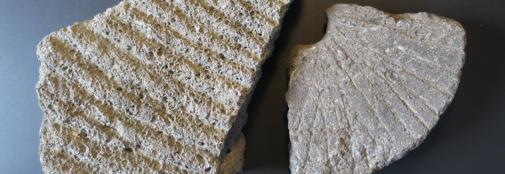Geoarchaeology and raw materials
 A raw material analysis identifies the raw material of any given object whether an unworked raw material, a composite material or an artefact. The primary aim is to assign as specific a geographic provenance as possible.
A raw material analysis identifies the raw material of any given object whether an unworked raw material, a composite material or an artefact. The primary aim is to assign as specific a geographic provenance as possible.
Raw material analysis employs basic non-destructive petrographic analysis using stereomicroscopy to describe mineralogy, and texture along with XRF (X-ray fluorescence) to determine the elemental composition of various materials. This can be usefully employed to describe the type of stone comprising a lithic artefact (e.g. was a quern stone made of sandstone, gneiss or basalt or was at whetstone made of Eidsborg slate?). This combination of techniques can also be used to characterize artificial composite materials like brick, glass/glaze, plaster, ceramics, and alloyed metals. Because we do not have extensive comparative collections for direct comparison we cannot normally determine precise provenance for these. However, the ratio of tin to lead and copper in a pewter item or the amount and type of base metal in a historic silver coin is information the archaeologist can use along with published material to address questions of origin, production and exchange.
The objective of a Geoarchaeological analysis is to understand the depositional environment and formation processes that produce archeological fill sequences and features, specifically the source of sediment and how they accumulated. The analysis includes a description of the sediments composition, including its minerogenic texture (proportion of sand, silt and clay), organic matter and carbonate content as well as hammer-scale and slag, incorporated macrofossils (seeds, charcoal, fishbone), and if requested microfossils (i.e. pollen, algae and spores). This type of data can be used to determine if discrete layers are in fact homogeneous and if they were dumped in distinct intervals (e.g. grave fill or leveling layers) or accumulated gradually as colluvium or sheet-wash from surrounding surfaces. This information is also critical to identifying accretional floors and cultivated surfaces as well as the sources of midden and latrine fill (e.g. feces or manure from stalls or domestic trash etc.). These analyses require monoliths or discreet bagged samples collected and plotted from profiles or plan excavations.
Contact

Pernille Bangsgaard
Senior researcher
Research: Animal bones
Phone: +45 51 31 79 38
Email: pernille.bangsgaard@sund.ku.dk

Anthony Ruter
Senior researcher
Research: Pollen and Macrofossils
Phone: +45 60 18 67 69
Email: anthony.ruter@sund.ku.dk
